
Detail of the Milwaukee Art Museum exhibition, Furniture Fakes from the Chipstone Collection, February 15, 2002–June 9, 2002. (Photo, Gavin Ashworth). The objects in this vignette are from left to right: Tea table, American, ca. 1958. Mahogany. H. 26 1/2", W. 32 3/4", D. 22 3/4"; Tea table, Newport, Rhode Island, 1765–1785. Mahogany. H. 27", W. 23", D. 32" (private collection); Bureau table, Newport, Rhode Island, 1765–1780. Mahogany with white pine, chestnut, and tulip poplar. H. 32 1/2", W. 37", D. 20 3/4". The tea table on the left is a complete fake inspired by authentic examples like the one in the center. The bureau table is a period example with replaced feet and foot blocks that have been distressed and colored to make them appear original. Both of the fakes were sold as authentic with no major repairs or replacements.

Chest-on-chest, Providence, Rhode Island, 1765–1780. Mahogany with chestnut, cherry, and white pine. H. 82 1/2", W. 42", D. 21 1/2". (Chipstone Foundation; photo, Gavin Ashworth.)

Chest of drawers, Newport, Rhode Island, 1765–1780. Mahogany with chestnut and white pine. H. 32", W. 37 1/2", D. 22". (Chipstone Foundation; photo, Gavin Ashworth.)

View of the living room at Chipstone, Milwaukee, Wisconsin, ca. 1975. (Chipstone Foundation.)

View of the living room at Chipstone, Milwaukee, Wisconsin, ca. 1975. (Chipstone Foundation.)

Upholstered armchair, American, ca. 1965. Mahogany with maple and pine. H. 43 3/4", W. 31 1/2", D. 31 1/2". (Chipstone Foundation; photo, Gavin Ashworth.)

Lolling chair, Portsmouth, New Hampshire, 1800–1810. Mahogany and satinwood with birch and white pine. H. 45 3/4", W. 25 1/2", D. 30". (Courtesy, Milwaukee Art Museum; gift of Mr. and Mrs. Robert Stenger.)

Upholstered armchair, Boston or Salem, Massachusetts, 1760–1770. Mahogany with maple. H. 35", W. 27 1/4", D. 25 1/4". (Chipstone Foundation; photo, Gavin Ashworth.) With its low back and serpentine crest, this armchair is a Boston version of a “French chair.” In the second edition of The Gentleman and Cabinet-Maker’s Director (1755), Thomas Chippendale noted that the carving on such chairs “may be lessened by an ingenious workman without detriment.”

Detail of the artificial distressing on the surface of a leg of the armchair illustrated in fig. 6.

Detail of nail holes under a knee block of the armchair shown in fig. 6.

Easy chair, American, ca. 1955. Mahogany with maple and pine. H. 49", W. 35 1/4", D. 29". (Chipstone Foundation; photo, Gavin Ashworth.)

Easy chair, Boston, Massachusetts, 1745–1765. H. 46 1/2", W. 34 5/8", D. 21 3/8". Walnut and maple with white pine, birch, and maple. (Courtesy, Milwaukee Art Museum.)

Detail of the right front leg of the easy chair illustrated in fig. 11.

Detail of the left quarter-round tenon of the easy chair illustrated in fig. 11.
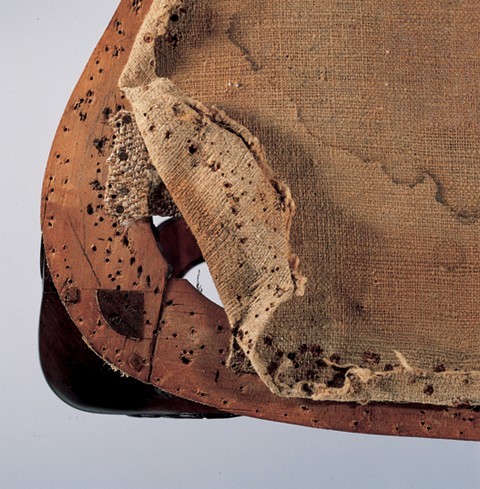
Detail of a ca. 1730 Boston backstool with quarter-round tenons similar to those of the easy chair illustrated in fig. 12.The tenon has a color and burnished appearance that differs markedly from the one shown in fig. 14.

Detail of the right rear leg of the easy chair illustrated in fig. 11, showing the spliced joint.

High chest illustrated in Ralph Carpenter’s The Arts and Crafts of Newport (Courtesy, Yale University Art Gallery, Mabel Brady Garvan Collection).

Detail of the leg of the high chest shown in fig. 17. (Courtesy, Yale University Art Gallery, Mabel Brady Garvan Collection.)
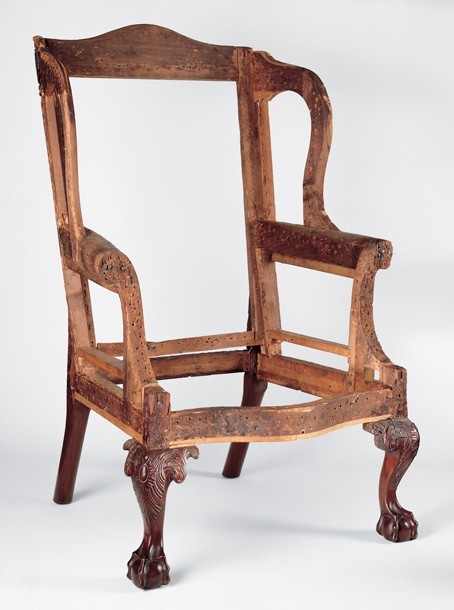
Easy chair, American, ca. 1958. Mahogany with tulip poplar, pine, and oak. H. 48 1/2", W. 33 1/2", D. 32 1/2". (Chipstone Foundation; photo, Gavin Ashworth.)

John Walton advertisement, Antiques 101, no. 4 (April 1971): 568. (Courtesy, Antiques.) The knee acanthus and feet of this chair are by the same hand that carved a dressing table and side chair that descended in the Gratz family. The latter examples are in the Winterthur Museum. www.themagazineantiques.com

Detail of the knee carving on the easy chair illustrated in fig. 19.

Detail of the right front leg and side rail of the easy chair illustrated in fig. 19.

Armchair attributed to a member of the Gaines family, vicinity of Portsmouth, New Hampshire, 1730–1745, with a crest rail dating ca. 1964. Maple with pine. H. 42 1/2", W. 26 1/2", D. 23 3/4". (Chipstone Foundation; photo, Gavin Ashworth.)

Detail of the crest rail of the armchair illustrated in fig. 23.

Armchair attributed to a member of the Gaines family, vicinity of Portsmouth, New Hampshire, 1730–1745. H. 43", W. 29 1/4", D. 21 3/8". Maple and cherry. (Courtesy, Winterthur Museum.)

Detail of the crest rail of the armchair illustrated in fig. 25.

Armchair, American, ca. 1962. Mahogany with pine and poplar. H. 43 1/2", W. 33", D. 24 1/2". (Chipstone Foundation; photo, Gavin Ashworth.)

Side chair with carving attributed to Nicholas Bernard, Philadelphia, 1750–1755. H. 39 1/8", W. 23 1/4", D. 21 1/2". (Courtesy, Milwaukee Art Museum.)

Detail of the knee carving on the armchair illustrated in fig. 27.

Detail of the knee carving on the chair illustrated in fig. 28.

Card table, American, ca. 1959. Mahogany with white pine. H. 29", W. 32", D. 15 1/4". (Chipstone Foundation; photo, Gavin Ashworth.)

Card table illustrated in the catalogue of the Loan Exhibition of Eighteenth and Nineteenth Century Furniture and Glass… for the Benefit of the National Council of Girl Scouts (New York: American Art Galleries, 1929), no. 627.

Detail of the underside of the card table illustrated in fig. 31. The undersides of the front and side rails have been colored with black stain.

Detail of the underside of a Newport card table dating 1765–1775. (Chipstone Foundation; photo, Gavin Ashworth.) The secondary surfaces of this card table are very diVerent from those of the fake illustrated in fig. 33. All of the components are the same color because they have been exposed to the same atmospheric conditions and level of light. The fine file marks on the undersides of the rail and knee blocks are typical of eighteenth-century Newport work.

Card table, American, ca. 1958. Mahogany with oak and tulip poplar. H. 26 1/2", W. 33 1/2", D. 16 1/2". (Chipstone Foundation; photo, Gavin Ashworth.)

Illustration of a New York card table in Joseph Downs, American Furniture: Queen Anne and Chippendale Periods in the Henry Francis du Pont Winterthur Museum (New York: MacMillan Co., 1952), nos. 340–41.

Detail of the knee carving on the card table illustrated in fig. 35.

Detail of a pin securing a mortise-and-tenon joint on the card table illustrated in fig. 35.

Detail of a pin securing a mortise-and-tenon joint on a New York card table with carving attributed to Henry Hardcastle (active 1750–1755). All of the pins securing the mortise-and-tenon joints are slightly distorted, and they protrude just above the surface of the leg stiles. The fractures extending from the corners indicate that the maker drilled his holes with a spoon-bit.

Details of the underside of the card table illustrated in fig. 35 showing (from left to right) the drawer inserted and the drawer withdrawn. The drawer may have come from the interior of a desk or bookcase.

Oval table, American, ca. 1961. Walnut with maple and pine. H. 26", W. 26", D. 26". (Chipstone Foundation; photo, Gavin Ashworth.)
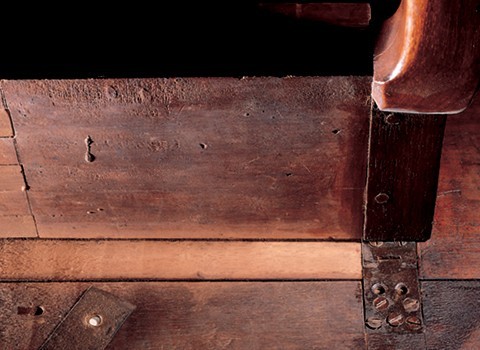
Detail of the top of the table illustrated in fig. 41.

Detail of the inner frame of the table illustrated in fig. 41.

Candlestand, American, ca. 1959. Mahogany. H. 27 3/8", Diam. of top: 22 1/4". (Chipstone Foundation; photo, Gavin Ashworth.)

Detail of the knee carving on the candlestand illustrated in fig. 44.
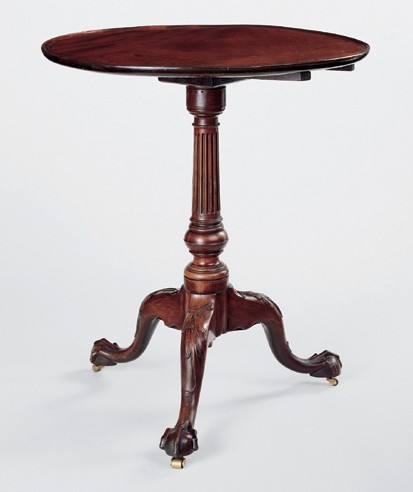
Candlestand, Philadelphia, Pennsylvania, 1765–1775. Dimensions not recorded. (Private collection; photo, Gavin Ashworth.)

Detail of the knee carving on the candlestand illustrated in fig. 46.

Detail of the top of the candlestand illustrated in fig. 44.

Detail of a plugged hole on the underside of the top of the candlestand illustrated in fig. 44.

Detail showing the edge molding of the candlestand illustrated in fig. 44. This molding was cut with a router and edge tools rather than being turned on a lathe.
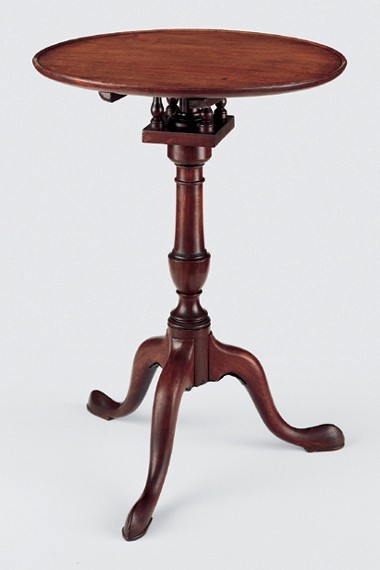
Candlestand, Philadelphia, 1780–1800. Mahogany. H. 27 1/4", Diam. of top: 27 7/8". (Private collection; photo, Gavin Ashworth.)

Detail of the underside of the top, birdcage, and battens (removed) of the candlestand illustrated in fig. 51. The bearing surfaces on stands and tea tables of this form are: the underside of the top bearing on the top board of the birdcage; the uppermost tip of the pillar on the hole in the underside of the top board of the birdcage; the shoulder of the tip on the underside of the top board of the birdcage; the collar on the upper side of the bottom board of the birdcage; and the underside of the bottom board of the birdcage on the large shoulder below. The wear on all of these surfaces should be consistent if all of the components are original.

Candlestand, American, ca. 1961. H. 27", Diam. of top: 22". (Chipstone Foundation; photo, Gavin Ashworth.)

Dressing table, American, ca. 1957. Mahogany with tulip poplar and yellow pine. H. 30 3/4", W. 34", D. 22". (Chipstone Foundation; photo, Gavin Ashworth.)
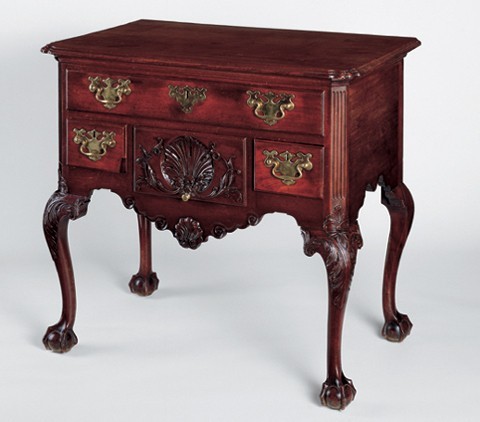
Dressing table attributed to the shop of Henry Clifton and Thomas Carteret, Philadelphia, Pennsylvania, 1750–1755. Mahogany with pine and white cedar. H. 30 3/4", W. 34", D. 21". (Private collection; photo, Gavin Ashworth.) This dressing table is a superb example of Philadelphia case furniture from the early 1750s. Its construction is nearly identical to that of a dressing table and matching high chest made by Clifton and Carteret in 1753 (Colonial Williamsburg Foundation). Like those objects and other comparable forms documented and attributed to their shop, this dressing table has dustboards below the lower drawers.

Detail of the carving on the lower center drawer of the dressing table illustrated in fig. 55.
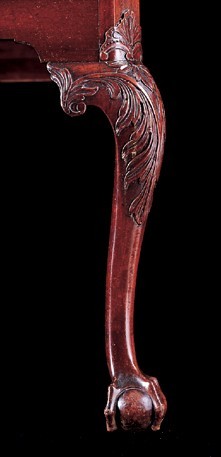
Detail of the knee carving on the dressing table illustrated in fig. 55.

Detail of the carving on the lower center drawer of the dressing table illustrated in fig. 54.

Detail of the knee carving on the dressing table illustrated in fig. 54.

Detail of the bottoms of two lower drawers from the dressing table illustrated in fig. 54.

Detail of the underside of the top of the dressing table illustrated in fig. 54.

Dressing table, American, ca. 1958. Mahogany with maple, chestnut, and tulip poplar. H. 33 1/4", W. 35 1/8", D. 20 1/2". (Chipstone Foundation; photo, Gavin Ashworth.)

Detail showing the interior case construction of the dressing table illustrated in fig. 62. The undersides of the rails were finished with a rasp rather than a file as was common in eighteenth-century Newport shops.
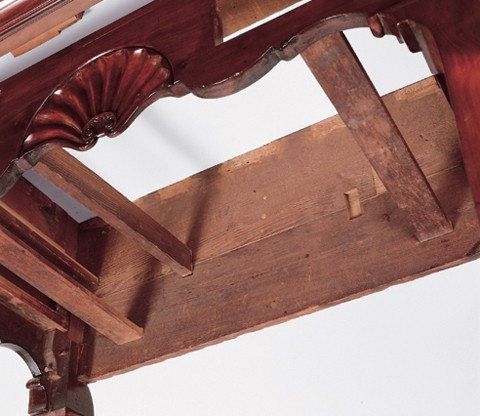
Detail showing the interior case construction of the dressing table illustrated in fig. 62.

Detail showing the drawer fronts, skirt, and carved shell of the dressing table illustrated in fig. 62. The convex and concave lobes of the shell are poorly regulated, and the central palmette is clumsy and overwrought. The faker responsible for this object was simply not up to the task of replicating eighteenth-century carving, even that as simple as the ornament commonly found on Newport furniture.

Detail showing the interior case construction of the dressing table illustrated in fig. 62.

Detail of the right front foot of the dressing table illustrated in fig. 62.
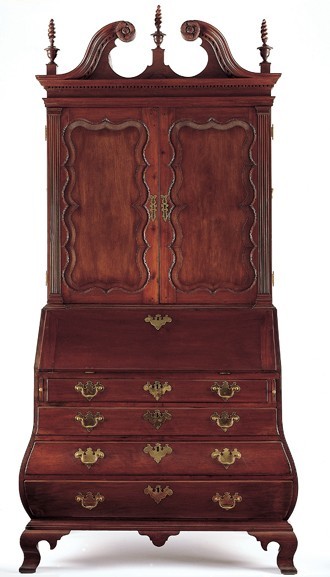
Desk-and-bookcase, Boston, Massachusetts, 1760–1770, with disguised repairs dating ca. 1956. Mahogany with white pine. H. 96", W. 41", D. 20 1/4". (Chipstone Foundation; photo, Gavin Ashworth.)
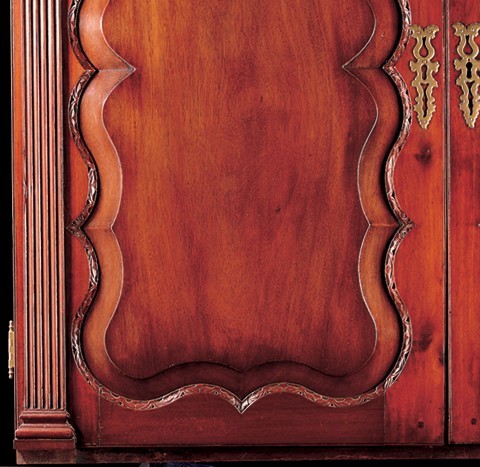
Detail of the left door of the desk-and-bookcase illustrated in fig. 68.

Detail of the inner surface of the left door of the desk-and-bookcase illustrated in fig. 68.

Detail of the foot and base construction of the desk-and-bookcase illustrated in fig. 68.

Detail of the back of the pediment of the desk-and-bookcase illustrated in fig. 68.

Desk-and-bookcase with carving attributed to John Welch, Boston, Massachusetts, ca. 1750. Mahogany with white pine. H. 97", W. 40 1/2", D. 23". The turned feet and finials, tromp l’oeil decoration inside the bookcase, and carving are the work of independent specialists contracted by the shop master. (Chipstone Foundation; photo, Gavin Ashworth.)
